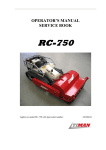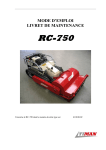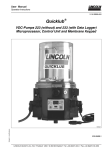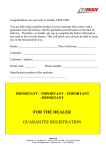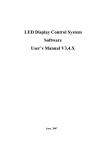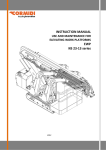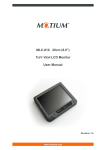Download Service manual RC-750
Transcript
Service manual RC-750 Valid for RC-750 type and serial number: 410100-01 Page 1 / 57 1 REMOVING GUARDS ........................................................................................................ 4 1.1 1.2 1.3 1.4 1.5 1.6 2 PROPULSION SYSTEM...................................................................................................... 7 2.1 2.2 2.3 2.4 2.5 2.6 2.7 2.8 2.9 3 TIGHTENING AND MAINTENANCE OF DRIVING BELTS ...................................................... 7 TIGHTENING THE BELTS BETWEEN THE ENGINE AND CLUTCH ......................................... 8 TIGHTENING THE BELTS BETWEEN THE ENGINE AND HYDRAULIC PUMP .......................... 9 TIGHTENING THE BELTS BETWEEN THE CLUTCH AND MOWING MECHANISM ................. 10 REPLACING THE BELT BETWEEN THE ENGINE AND HYDRAULIC PUMP ........................... 11 REPLACING THE BELTS BETWEEN THE CLUTCH AND MOWING MECHANISM ................... 12 REPLACING THE BELTS BETWEEN THE ENGINE AND CLUTCH ......................................... 13 REPLACING THE CLUTCH AND FLANGE BEARINGS ......................................................... 16 REPLACING THE GUARD BEARING ................................................................................. 19 MOWING MECHANISM .................................................................................................. 21 3.1 3.2 3.3 3.4 4 REMOVING THE BRANCHES PROTECTIVE GUARD ............................................................. 4 REMOVING THE HYDRAULICS GUARD ............................................................................. 4 REMOVING THE GUARD ON THE RIGHT SIDE OF THE ENGINE............................................ 5 REMOVING THE BLACK GUARD IN FRONT OF THE CLUTCH .............................................. 5 REMOVING THE ENGINE COMPARTMENT GUARD ............................................................. 6 REMOVING THE MOWING MECHANISM GUARD ................................................................ 6 REMOVING THE FLAIL AXIS ........................................................................................... 21 REPLACING THE BEARINGS IN THE FLAIL AXIS .............................................................. 23 FLAIL CUTTERS, HANGERS AND SCREWS ....................................................................... 25 REPLACING THE CASES OF SUPPORTING ARMS .............................................................. 26 BELTS ................................................................................................................................. 27 4.1 4.2 4.3 4.4 4.5 4.6 BELTS TENSION............................................................................................................. 27 REPLACING BELTS ........................................................................................................ 28 REPLACING THE BEARINGS IN THE RETURN PULLEY ...................................................... 29 REPLACING THE BEARINGS IN THE BEARING PULLEY .................................................... 30 REPLACING THE HYDRAULIC WHEELS MOTOR............................................................... 31 SPIKES ASSEMBLY ........................................................................................................ 32 5 RUBBER BELT HANGERS .............................................................................................. 33 6 AIR TRAP RUBBER BUMPS ........................................................................................... 33 7 HYDRAULICS ................................................................................................................... 34 7.1 7.2 7.3 7.4 7.5 7.6 7.7 8 CHECKING THE HYDRAULIC OIL LEVEL ......................................................................... 34 REPLACING THE GEAR OIL AND FILTER ......................................................................... 35 MACHINE TOWING ........................................................................................................ 36 CHECKING HYDRAULIC PRESSURE ................................................................................ 37 REPLACING THE PUMP .................................................................................................. 38 CLEANING THE OIL-COOLER ......................................................................................... 40 HYDRAULICS DIAGRAM ................................................................................................ 41 SERVO-ENGINE................................................................................................................ 42 8.1 8.2 8.3 REPLACING THE SERVO-ENGINE ................................................................................... 42 REPLACING THE POTENTIOMETER ................................................................................ 45 SETTING THE ZERO POSITION OF THE SERVO-ENGINE .................................................... 46 Page 2 / 57 9 TILT SENSOR .................................................................................................................... 47 10 MOWING MECHANISM SAFETY SENSOR .............................................................. 48 11 REMOTE CONTROL..................................................................................................... 49 11.1 11.2 12 ZERO POSITION PROGRAMMING .................................................................................... 49 FREQUENCY CHANGE .................................................................................................... 49 DESCRIPTION OF THE ELECTRICAL BOX ............................................................. 50 12.1 ELECTRICAL DIAGRAM ................................................................................................. 51 13 TROUBLESHOOTING .................................................................................................. 52 14 HONDA IGX 440............................................................................................................ 54 14.1 14.2 14.3 14.4 14.5 MODIFICATION OF HONDA IGX440 ENGINE ................................................................. 54 DIAGNOSTIC CONNECTION ............................................................................................ 55 REPLACING THE MOTOR OIL.......................................................................................... 55 FUEL SYSTEM TROUBLESHOOTING ................................................................................ 56 HONDA ENGINE SERVICE MANUAL ............................................................................... 57 Page 3 / 57 1 REMOVING GUARDS 1.1 Removing the branches protective guard The protective guard is removed as follows: 1 D 1. Loosen the screws holding the protective guard in the front part of the machine. 2. Tilt the protective guard backwards. 3. Tilt the protective guard around the centre of rotation on the rear part of the machine and lay it on the floor. 1.2 3 Removing the hydraulics guard 1 2 1. Loosen the six screws holding the guard. 2. Lift the guard directly up and remove it from the machine. Page 4 / 57 1.3 Removing the guard on the right side of the engine First, remove the branches protective guard and the hydraulics guard, see sections 1.1, 1.2. 1 2 1. Loosen the rear screw. 2. Press the belt with the left hand and lift off the guard sideways. 1.4 Removing the black guard in front of the clutch First, remove the branches protective guard, the hydraulics guard and the guard on the right side of the engine. See sections 1.1-1.3. 1 1. Loosen the three screws and then lift up the guard. Page 5 / 57 1.5 Removing the engine compartment guard First, remove the branches protective guard and also the hydraulics guard. See sections 1.1, 1.2. 1 2 3 1. The guard on the right side. 2. Loosen the two screws between the belts. 3. Then lift up the guard. 1.6 Removing the mowing mechanism guard 1 2 1. Loosen the six screws holding the guard, three on the upper side and three on the lower side. 2. Then remove the guard. Page 6 / 57 2 Propulsion system 2.1 Tightening and maintenance of driving belts To ensure that the belts are set and maintained correctly a belt tightening tester is supplied with the machine. Driving with belts that are too loose will considerably reduce the lifetime and efficiency of the belts and the driving pulleys will wear very quickly. If the belts are too tight, it will increase wear and tear on the machine bearings. The belt tightening tester is used as follows: 1. Before you start measuring, turn the transmission several times to spread the tension across the entire belt. 2. Place the belt tightening tester between the driving pulleys and push the pointer to the scale. 3. Only use one finger to control the belt tightening tester. 4. Activate the tester slowly by increasing the pressure until you hear/feel a click after which do not exert pressure. 5. Remove the tester from the belt and read the tension in the intersection of the scale and the front part of the pointer. 6. Continue setting the belt tension until the value measured and the value in the table below are equal. After each adjustment, turn the transmission several times to make sure that the belt tension near the driving pulley is the same as in the rest of the belt. Static belt tension (N) Belts between the engine and clutch Belts between the engine and pump Belts between the clutch and mowing mechanism New belt Used belt 375 300 250 225 375 300 Important: After tightening turn the transmission several times to spread the tension of the belt evenly. Page 7 / 57 2.2 Tightening the belts between the engine and clutch First, remove the branches protective guard, the hydraulics guard and the guard on the right side of the engine. See sections 1.1, 1.2 and 1.3. Belt tension adjusting nut Location of the engine screws Lock-nut Tighten the belts as follows: 1. Loosen the four screws holding the engine. 2. Loosen the lock-nuts on the setting fitting. 3. Continue adjusting the lock-nuts until the belt tension is 375 N for a new belt and 300 N for a used belt. 4. Using the horizontal batten check whether the driving pulley of the engine is parallel to the clutch. If not, adjust the lock-nuts. Check the belt tension afterwards. 5. Tighten the screws of the engine and lock-nuts. Important: After tightening turn the transmission several times to spread the belt tension evenly. Page 8 / 57 2.3 Tightening the belts between the engine and hydraulic pump First, remove the branches protective guard, the hydraulics guard and the guard on the right side of the engine. See sections 1.1, 1.2 and 1.3. Pump screws Adjusting screw Tighten the belts as follows: 1. Loosen the two screws holding the pump. 2. Loosen the lock-nut of the adjusting screw. 3. Continue adjusting the adjusting screw until the belt tension is 250N for a new belt and 200N for a used belt. 4. Tighten the screws of the pump and lock-nuts. Important: After tightening turn the transmission several times to spread the belt tension evenly. Page 9 / 57 2.4 Tightening the belts between the clutch and mowing mechanism First, remove the mowing mechanism guard. See section 1.6. Adjusting screw Lock-nut Mowing mechanism screws Horizontal batten Tighten the belts as follows: 1. Loosen the four screws holding the mowing mechanism, two screws on each side. 2. Loosen the lock-nuts on the adjusting screws. 3. Continue adjusting the nut on the adjusting screw until the belt tension is 375N for a new belt and 300N for a used belt. 4. Using the horizontal batten, check whether the mowing mechanism driving pulley is parallel to the clutch. If not, adjust the nuts. Check the belt tension afterwards. 5. Tighten the screws of the mowing mechanism and also the nuts. Important: After tightening turn the transmission several times to spread the belt tension evenly. Page 10 / 57 2.5 Replacing the belt between the engine and hydraulic pump The belt is replaced as follows: First, remove the branches protective guard, the hydraulic pump guard and the guard on the right side of the engine. See sections 1.1, 1.2 and 1.3. 2. 1. 2. 1. Loosen the two screws holding the pump. 2. Loosen the adjusting screw nut and tilt the pump towards the engine. 3. Now the belt can be removed. Assemble in the reverse order from removing. See section 2.3 for the correct belt tension. Page 11 / 57 2.6 Replacing the belts between the clutch and mowing mechanism The belts are replaced as follows: First, remove the mowing mechanism guard. See section 1.6. 1. 2. 3. 4. 1. Remove the belt shaft. 2. Lift up the mowing mechanism to the service position and remove the belt. 3. Lift up the machine so that the mowing mechanism is in the lowest position. 4. Remove the mowing mechanism belts. Assemble in the reverse order from removing. Tighten as in section 2.4. Page 12 / 57 2.7 Replacing the belts between the engine and clutch The belts are replaced as follows: First, remove the branches protective guard, the hydraulic pump guard, the guard on the right side of the engine, the guard in front of the clutch and the mowing mechanism guard, see sections 1.1, 1.2, 1.3, 1.4 and 1.6. 2. 1. 3. 5. 4. 6. 1. Remove the belt shaft. 2. Lift up the mowing mechanism to the service position and remove the belt from the driveshaft. 3. Remove the driving pulley screw. Use the impact wrench. 4. Loosen the two hexagon screws in the Taper Lock case. Page 13 / 57 5. Screw the hexagon screw to the free thread. Tighten the screw to remove the V-belt driving pulley and the Taper Lock case. 6. Remove the V-belt driving pulley and the Taper Lock case. 8. 7. 11. 13. 12. 14. 7. Unscrew the four belt guard screws and remove the guard from the shaft. 8. Lift up the mowing mechanism to the service position. 9. Remove the hydraulic pump belt. See section 2.5. 10. Loosen the engine and set it to the adjusting screws so that the belts are loose. See section 2.2 on tightening belts between the clutch and engine. 11. Loosen the two screws holding the most rearward flange bearing. 12. Pull out the belt from the clutch driving pulley and lay it towards the chassis. 13. Turn the flange bearing approximately 25 degrees using a wrench. 14. Turn the shaft upwards and remove the belts. If the belt is too tight, it is better to loosen it before you lift up the shaft. See section 4.1. Page 14 / 57 Assemble in the reverse order from removing. Please note the following: 17. 16. 15. Tighten the belt as shown in section 2.2. 16. The screws holding the guard must be treated with Loctite (thread securing). 17. The central screw holding the Taper Lock case must be tightened before tightening the hexagon screws in the driving pulley. The screw holds the internal bearing ring of the guard in place. The screw must be treated with Loctite (thread securing). The hexagon screws are tightened to 20 NM. Page 15 / 57 2.8 Replacing the clutch and flange bearings The clutch and bearings are replaced as follows: Follow the instructions for replacing the belts between the clutch and engine up to and including point 11. See section 2.7. Follow the instructions for replacing the servo-engine up to and including point 8. See section 9.1. 1. 3. 2. 4. 1. Remove the electric connection of the clutch and the lubricating hose of the flange bearing. 2. Loosen the two screws holding the inner flange bearing, use a socket wrench with a long extension. 3. Loosen the belt, see section 4.1. Lift up the belt and pull out the clutch from the machine at the same time. 4. Fix the clutch in a vice, loosen the screw holding the flange bearing and remove the bearing. Page 16 / 57 5. 6. 8. 7. 9. 10. 5. Remove the clutch coil. 6. Remove the driving pulley and claw clutch. 7. When assembling the driving pulley the screw must be treated with Loctite (thread securing). 8. When assembling the screw holding the flange bearing treat the screw with Loctite (thread securing). 9. Remove the groove and distance ring. 10. Remove the guard bearing case. Page 17 / 57 12. 11. ‘ 11. Loosen the setscrews on the flange bearing and remove the bearing. Assemble in the reverse order from removing. Please note the following: 12. When installing the clutch on the machine make sure that the force arm of the clutch is in the lock of the machine. 13. The setscrews of the bearing can be tightened after the screws holding the flange bearings are tightened. Page 18 / 57 2.9 Replacing the guard bearing The guard bearing is replaced as follows: Follow the instructions for replacing the belts between the clutch and engine up to and including point 6. See section 2.7. 2 1 3 4 1. Remove the four guard screws and the distance ring and groove. 2. Pull out the guard above the shaft and place the mowing mechanism in the service position. 3. Pull out the bearing sleeve from the shaft using the shaft clamp. 4. Remove the lock ring and Nilos ring, then remove the bearings from the bearing sleeve and mount the new bearings. Page 19 / 57 Assemble in the reverse order from removing. Please note the following: 5. 6. 5. The screws holding the guard must be treated with Loctite (thread securing), the assembly of the Nilos ring and distance ring is shown in the picture. 6. The central screw holding the Taper Lock case must be tightened before tightening the hexagon screws in the driving pulley. The screw holds the internal bearing ring of the guard in place. The screw must be treated with Loctite (thread securing). The hexagon screws are tightened to 20 NM. 7. Tighten the belt according to section 2.4. Page 20 / 57 3 MOWING MECHANISM 3.1 Removing the flail axis The flail axis is removed as follows: First, remove the mowing mechanism protective guard, see section 1.6, and follow the instructions for removing the belt described in section 2.6. 1. 3. 2. 4. 1. Remove the two screws of the inner guard, note the distance ring between the two washers of the screw. 2. Mount two approved lifting hangers to the lifting eyes on the mowing mechanism. 3. Loosen and remove the two setscrews of the mowing mechanism and also the four screws holding the mowing mechanism. 4. The mowing mechanism can now be unfastened from the arms and inner guard. Page 21 / 57 5. 6. 7. 8. 10. 9. 5. Remove the vertical positioning shaft. 6. Remove the chain pulley holder. 7. Loosen the three screws holding the closing plate and remove the plate. 8. Remove the lubricator on the left side of the mowing mechanism. 9. Remove the bearing sleeves screws on the right and left side of the mowing mechanism. 10. Lift up the flail axis from the shield of the mowing mechanism. Page 22 / 57 3.2 Replacing the bearings in the flail axis The bearings on the left side are replaced as follows: 1. 2. 3. 4. 5. 6. 1. Note the O-ring on the left side of the bearing sleeve which keeps water outside the bearings. 2. Loosen the nut holding the bearing. 3. Remove the bearing sleeve using the clamp. 4. Replace the bearings and mount them according to the pictures, start with the bearing on the right. 5. Make sure that the oil seal ring is turned according to the pictures. When mounting use a special jack because otherwise the oil seal ring might be damaged. 6. When mounting make sure the screw is treated with Loctite (thread securing). Page 23 / 57 The bearings on the right side of the flail axis are replaced as follows: 1. 2. 3. 4. 5. 6. 1. 2. 3. 4. Remove the nut, self-locking washer and driving pulley. Remove the distance tube, note that the oil hole faces towards the bearings. Remove the bearing sleeve using the clamp. Replace the bearings and mount them according to the pictures, start with the bearing exactly on the right. The oil seal ring must be oriented according to the picture on the previous page. 5. Turn the bearing sleeve and mount the oil sleeve ring. 6. Assemble in the reverse order from removing. Please note the following: 7. When mounting the flail axis the eight screws holding the bearing sleeve must be treated with Loctite (thread securing). Page 24 / 57 3.3 Flail cutters, hangers and screws The machine can have two types of flail cutters: Y-shaped cutters or hammer flail cutters. When servicing check the following: - The number of Y-shaped cutters is 32 and the number of hammer flail cutters is 16. - The flail axes hangers must rotate freely. - If the cutters show signs of wear and tear replace them. Case The picture shows a new and used Y-shaped flail cutter. When replacing check the wear and tear of the hanger where the cutter is suspended. If the hanger is worn, replace it. When replacing the flail cutter always replace the screw and nuts on which the hanger is suspended. Where the hanger will wear The picture shows a new and used hammer flail cutter. When replacing check the hangers. Replace the screws and nuts. Replace the flail cutters before they are completely worn-out, new flail cutters mow better. Adjust the mowing height according to the conditions and never allow the flail cutters to touch the ground. Important: When replacing flail cutters all cutters must be replaced otherwise the flail axis will be unbalanced. When replacing the flail cutters always replace the screw and nuts. Worn out screw which must be replaced Page 25 / 57 3.4 Replacing the cases of supporting arms Cases are replaced as follows: 2. 1. 3. 1. Put the mowing mechanism into the service position. 2. Remove the springs of the supporting arms. 3. Replace the cases. Page 26 / 57 4 Belts 4.1 Belts tension To measure if the belts of the machine are adjusted correctly, use a tape measure placed in front of the central chain pulley and measure approx. 210 mm. Push the upper side of the belt above the central chain pulley and measure the value on the tape. The value of a correctly tightened belt is 180 mm. If the belt is too loose, adjust it as follows: 1. Loosen the lock-nuts. 2. Loosen the rear closing screw. 3. Tighten the belt by screwing the adjusting screw inside. After adjusting and checking the belt tension, tighten the closing screw and lock-nuts. Adjusting screw Lock-nut Closing screw Page 27 / 57 4.2 Replacing Belts Belts are replaced as follows: To replace the belts on the right side follow the instructions for replacing the belt between the engine and clutch up to and including point 8. See section 2.7. 1. 2. 3. 4. 1. Remove the guard. 2. Loosen the two lock-nuts and unscrew the adjusting screws to remove tension from the belt. 3. Loosen the nut and remove the return pulley using the clamp. 4. Now the belt can be removed. Assemble in the reverse order from removing. When assembling pull the belt backwards and push the return pulley over the shaft at the same time. Page 28 / 57 4.3 Replacing the bearings in the return pulley Remove the return pulley according to section 4.2. 1. 2. 1. When replacing the bearings it is also important to replace the Nilos rings. 2. Now the bearings can be replaced. When mounting, be careful that the Nilos ring does not lay on the edge of the lock ring groove. After the pulley is mounted on the machine, do not forget to mount the distance ring otherwise the washer will damage the Nilos ring. The picture shows a cross-section of the bearing structure with the pulley mounted on the machine. Bearings Page 29 / 57 4.4 Replacing the bearings in the bearing pulley The bearings are replaced as follows: 1. 2. 3. 4. 1. 2. 3. 4. Remove the guard. Loosen the bearing pulley nut. Pull out the bearing pulley from the shaft using the clamp. Now the bearings can be replaced. When mounting, be careful that the Nilos ring does not lay on the edge of the lock ring groove. After the pulley is mounted on the machine, do not forget to mount the distance ring otherwise the washer will damage the Nilos ring. See the picture of the bearing structure on the previous page. Page 30 / 57 4.5 Replacing the hydraulic wheels motor The hydraulic wheels motor is replaced as follows: First, remove the branches protective guard, the hydraulics guard and the mowing mechanism guard, see sections 1.1, 1.2, 1.6. Follow the instructions for replacing belts up to and including point 4, see section 4.2. 1. 3. 1. Remove the hydraulic hoses of the pump. Block the hoses and fittings. 2. Remove the nut of the rubber shock absorber. 3. Remove the central screw on the lower side of the chassis. 4. Loosen the driving wheel screw. Lift up the belt hanger from the machine. 5. Remove the driving wheel using the clamp and then remove the wheels motor. 2. 4. 5. Assemble in the reverse order from removing but make sure the belt hanger is parallel to the chassis before tightening the screws [3] and [4]. When removing the belt hangers it is recommended to replace the cases in the tipping section. When mounting the new wheels motor the screws holding the engine must be treated with Loctite (thread securing). Page 31 / 57 4.6 Spikes assembly Spikes are mounted between every fourth pattern on the belt, see the picture. See the picture. Push the fitting inside and tighten the screw. A set of spikes includes the following: - 14 inner spikes with fittings - 14 outer spikes with fittings - 14 M10x25 screws - 28 M10 washers - 14 M10 closing nuts Page 32 / 57 5 RUBBER BELT HANGERS When servicing carefully check the rubber shock absorbers for cracks and other damage. The rubber hangers of the triangle are replaced as follows: 2. 1. 1. Remove the nut on the upper side of the triangle. 2. Turn the belt downwards, then the rubber shock absorber can be replaced. 6 AIR TRAP RUBBER BUMPS When servicing carefully check the rubber shock absorbers for cracks and other damage. 1. The simplest way to remove the two rear rubber shock absorbers is by using the long extension of the socket wrench [1]. Page 33 / 57 7 Hydraulics The hydraulic system consists of two variable hydraulic pumps each driving its hydraulic motor. To avoid dirtying the oil, the dipstick has a 3 mm air filter. The dipstick has an embedded 0.2 bar counter-valve which: - Keeps the oil in the tank when driving on slopes. - Prevents condensation in the tank. See the hydraulic diagram in section 7.7. 7.1 Checking the hydraulic oil level The hydraulic oil must always reach the cut-out in the dipstick. If the oil level is too low, refill. The oil must not contain water or impurities. Before unscrewing the dipstick, first always clean the surrounding area. Dipstick Oil level When refilling pour the oil slowly and carefully. Remove spilt oil immediately. In the factory the hydraulic tank is filled with Texaco Havoline Extra SAE 10W-40 classification API SJ semi-synthetic slightly flowing oil. Only use this oil. Before using another brand, contact Texaco for information on compatibility. Page 34 / 57 7.2 Replacing the gear oil and filter The gear oil and filter are replaced as follows: 1. 2. 3. 4. 5. 1. Remove the branches protective guard, loosen the two screws indicated by the arrow and tilt the equipment backwards. 2. Remove the hydraulics guard. 3. Replace the oil filter. Before mounting a new filter, do not forget to lubricate the gasket with oil. 4. Drain the oil off by loosening the oil drain plug. After draining tighten the plug again. 5. Fill with approx. 6 litres of 10W40 oil. Start the machine and let it run for about two minutes, then top up the oil. Page 35 / 57 7.3 Machine towing If the machine hydraulics fail or if the motor won’t start, the machine can be towed. First, remove the hydraulics guard, then turn each of the towing screws twice with a wrench. Now the machine can be towed. After towing, tighten the towing screws to 14 Nm. Towing screw - right pump Towing screw - left pump Note: There are two screws on the right side of each pump. The lower, “gold-coloured” screw is used for towing. Warning: Towing screws must only be loosened when the machine is on a flat surface. If the screws are loosened when the machine is on a slope the machine might start moving. Warning: Do not loosen the towing screws until the engine is completely cold because the engine exhaust pipe, which is near the screws, may burn you. Page 36 / 57 7.4 Checking hydraulic pressure The pumps have a safety relief valve which takes the oil to oil-consuming machine components when the pressure exceeds 160 bar. Important: Before checking the pressure, make sure the towing screws are tightened. When testing the hydraulic pressure, start by measuring the pressure of the hydraulic pump. Remove the hydraulic hoses between the engine and the measured pump. Block the reverse hose and insert the T-shaped connection and the testing lubricator to the forward circuit when the pressure is measured. See the picture below. The pressure is measured with the Honda engine idling and with the forward travel speed set to 50 %. If the pump is all right, the pressure will measure between 160 and 180 bar. 1. Forward circuit when the machine moves forward Backward circuit when the machine moves forward Pump The direction indicated in the picture for forward and backward circuits applies to both pumps. After checking the pressures of the pump, measure the engine pressure. First, insert the T-shaped connection and the testing Engine blocked lubricator to the forward circuit. Block the engine by inserting the iron rod or a piece of wood in the gap between the drive wheel and the belt. Engine Measure the pressure with the Honda engine idling and with a forward travel speed set to 50 %. If the engine is all right, the pressure will measure 160 bar. When testing the oil must be between 40 and 50o C. Pump Page 37 / 57 7.5 Replacing the Pump First, remove the branches protective guard, the pump guard and the guard on the right side of the engine, see sections 1.1, 1.2 and 1.3. Remove the hydraulic pump belt, see section 2.5. 1. 2. 3. 4. 1. 2. 3. 4. Drain the oil by loosening the oil drain plug. Remove the pressure hoses on the left and right engine. Remove the counter-valve at the T-shaped connection on the tank. Remove the belt tension adjusting screw on the pump. Page 38 / 57 6. 5. 7. 8. 9. 10. 5. Remove the hanger screw. 6. Remove the hanger screw. 7. Loosen and remove the suction hose. 8. Remove the reverse hose on the filter. 9. Lift up the pump from the machine. 10. Remove the ball joint of the arm, servo-engine support and the ventilator and driving pulley. When replacing the pump do not remove the arms of the servo-engine otherwise the zero position of the servo-engine must be recalibrated. See section 8.3 on setting the zero position of the servo-engine. Assemble in the reverse order from above. Important: treat all screws screwed into the pump and the pump shaft with Loctite (thread securing). Page 39 / 57 7.6 Cleaning the oil-cooler The cooler is cleaned as follows: First, remove the branches protective guard, see section 1.1. 1. 2. 3. 4. 1. Loosen the eight screws of the mesh and remove the two screws completely on the top in the middle. 2. Tilt the mesh backward and remove it by lifting it sideways up. 3. Loosen the four screws holding the cooler. 4. Clean the cooler with compressed air from the rear part of the cooler. Mount the cooler in the reverse order than stated above. Page 40 / 57 8 Servo-engine 8.1 Replacing the Servo-engine First, remove the branches protective guard, the hydraulics guard and the guard on the right side of the engine. See sections 1.1, 1.2 and 1.3. Remove the hydrostatic pump belt, see section 2.5. 1. 2. 3. 4. 1. Remove the pressure hoses to the left and right engine. 2. Remove the counter-valve at the T-shaped connection on the hydraulic tank. 3. Remove the belt tension adjusting screw on the pump. 4. Remove the hanger screw. Page 42 / 57 6. 5. 7. 8. 9. 10. 5. 6. 7. 8. Remove the hanger screw. Loosen the rotating device on the suction hose, approx. one turn. Remove the reverse hose on the filter. Lift the pump up 20 cm by fastening the lifting lugs around the pump. When lifting, check if the suction hose rotates. 9. Remove the reverse filter. 10. Loosen the servo-engine arm. Page 43 / 57 11. 13. 12. 14. 11. Remove the arm of the servo-engine with a screwdriver. 12. Loosen the three screws holding the servo-engine. 13. Remove the electrical connection of the servo-engine. 14. Remove the servo-engine. Assemble in the reverse order from above. Please note: 1. Assemble the servo-engine arm according to section 8.3. 2. The screws holding the servo-engine, see picture 12, must be treated with Loctite (thread securing). Page 44 / 57 8.2 Replacing the Potentiometer First, remove the branches protective guard, the hydraulic pump guard and the engine compartment guard. See sections 1.1, 1.2 and 1.5. 1. 2. 3. 4. 1. 2. 3. 4. Remove the electrical connection of the potentiometer. Loosen the two screws holding the potentiometer. Turn the potentiometer 90° clockwise. Remove the potentiometer. Do not forget the O-ring. Assemble in the reverse order from above. Please note: 1. Grease the O-ring before mounting it on the potentiometer so that it stays in place when assembling the potentiometer. 2. When assembling the potentiometer, see picture 2, make sure that the screws are located in the middle of the lengthwise holes in the potentiometer. Page 45 / 57 8.3 Setting the zero position of the servo-engine When the arms of the servo-engine are being remounted make sure that they are aligned correctly otherwise the machine will not go straight. Set as follows: 1. 2. 3. 4. 1. Before mounting the arms on the 5. servo-engine, supply electricity to the machine by pressing the emergency button on the remote control and on the machine. 2. Press the horn. 3. Put the left joystick in the maximum position to start the servo-engine shaft rotating. When the handle is released the servo-engine will automatically find the zero position. 4. Press the emergency button on the machine and on the remote control. 5. Push the servo-engine arm above the shaft. Make sure that the arm is perpendicular in the bend of the servo-engine support. Use an angle iron. Tighten the engine nut. When tightening the nut make sure that the shaft and the arm do not rotate around each other. Always check after assembling the arm. Then supply electricity to the machine and tilt it to the maximum using the remote control. Page 46 / 57 9 TILT SENSOR This sensor does two things. 1. Engine protection. The engine is approved and tested to drive on slopes with a maximum angle of 58 degrees. When driving on more than 58 degree slopes the engine loses its lubricating capability which can result in an accident.. 2. Protection against the machine turning over. The sensor works so that the pendulum activates the contact. When the contact is on for more than 1 second the machine starts beeping and the mowing mechanism stops. Warning: If the machine drives into a hole or if it skids on a slope, the sensor cannot react before the machine turns over. Contact Pendulum When checking the tilt sensor, swing the pendulum to its maximum with the engine running. The machine should start beeping. Page 47 / 57 10 MOWING MECHANISM SAFETY SENSOR To avoid starting/setting the machine in motion with the mowing mechanism in the service position, the machine has an NPN safety sensor which is activated when the arms of the mowing mechanism are lifted. 1. 2. The sensors are located according to the picture [1]. 3. Once the handle is activated and the mowing mechanism is lifted from the supporting arms influenced by the springs [2], the NPN sensor must be deactivated which stops the engine. When the sensor is not active, the NPN diode is not lit. The sensor is set by loosening the nut, see picture [3]. Make sure that the sensor is set so that the mowing mechanism does not deactivate the sensor when it is in a working position. The sensor has a working range of 5 mm. Page 48 / 57 11 REMOTE CONTROL 11.1 Zero position programming The machine is set by the manufacturer in the factory so when the joysticks are released, the machine idles. This can change over time and the zero position can be found again by programming the remote control. Before using this function, lift up both belts approx. 5 cm above ground with a fork lift truck or a jack using the lifting lug. Start the machine and set the revolutions to 20 %. 2 3 1 The find the zero position as follows: 1. Activate the PR button [1] for 3 seconds, the display will show PR. 4 2. To set the left belt move the joystick [2] to the left and release it. 5 3. Then activate the joystick [3] in several phases. If the belt reverses, move the joystick from the zero position completely forward and then release it. If the belt moves forward, move the joystick backwards. Repeat this until the left belt is idling. Now press the button [4] to save the setting. 4. To set the right belt move the joystick [2] to the right and release it. 5. Then activate the joystick [3] in several phases. If the belt reverses, move the joystick from the zero position completely forward and then release it. If the belt moves forward, move the joystick backwards. Repeat this until the right belt is idling. Now press the button [5] to save the setting. 6. Activate the emergency button on the remote control. 11.2 Frequency change If the remote control signal is interrupted, the machine stops automatically. To continue operating, change the channel on the remote control. Do this by holding the button [1] down and activating the button [2] at the same time. This will change the channel number. When the channel is changed, the horn beeps briefly to indicate the change. The number of the channel in shown on the display [3]. 3 2 1 Page 49 / 57 Horn GND Engine Start Throttle control 0-5V Clutch GND Tilt switch 5V Horn 12 V Left potentiometer GND Left potentiometer 5V Left servomotor A Left servomotor B Right potentiometer GND Right potentiometer 5V Right servomotor A Right servomotor B Clutch Ground for left potentiometer 5 V supply for left potentiometer Left servomotor lateral movement gets signal when left or right joystick is activated Left servomotor lateral movement gets signal when left or right joystick is activated Ground for right potentiometer 5 V supply for right potentiometer Right servomotor lateral movement gets signal when left or right joystick is activated Right servomotor lateral movement gets signal when left or right joystick is activated Clutch for cutter. Is deactivated on emergency stop at Timan control box. Remains engaged on emergency stop at remote control, to reduce the stopping time Can only be set if there is 0V to lamp Ground for clutch Circuit that breaks mechanically if machine is running at an inclination above 58 deg. Beeps automatically on activation of tilt sensor, and if emergency stop of machine is not activated before it is left alone Can be activated manually with remote control Ground for horn Start of Honda motor - can only start if safety circuit is ok Revolutions of Honda motor are changed When activating clutch, revolutions are automatically changed to 1900 rpm. After engagement the previously set value is found. Gets a signal when the emergency stop of the Timan control box is activated 12 V fixed voltage Feedback to steering that safety circuit is ok Coupling is deactivated if safety cicuit is broken Servomotors go into neutral position if safety circuit is broken Gets a signal when NPN sensor is ok, safety circuit there stops the motor, if K2 is broken Circuit is broken if emergency stop is activated Circuit that breaks mechanically if machine is running at an inclination abover 58 deg. If no signal - the clutch falls out and the machine starts beeping. Delay of approx. 1 sec. Charge light signal from motor 0V, if motor is running. 12 V if motor is turned on. Clutch is deactivated if there is 12V to the lamp Motor cannot start if there is 0V on charge light, to prevent activation of self-starter when motor is running. Feedback to steering about location of servomotors Feedback to steering about location of servomotors Description The machine stops automatically if: a disturbing frequency occurs; the machine gets out of reach of the remote control. Output Left potentiometer signal 0-5V Right potentiometer signal 0-5V Charging light Tilt switch input Run signal / stop NBB Control box Input Ground (GND) 12 V battery + Safety circuit ok / motor enable 12 DESCRIPTION OF THE ELECTRICAL BOX The box on the right side of the machine is a Timan control box. The box includes an emergency stop, hour counter, circuit breakers and relays, ignition indicator light and the supply of the NBB control box. See the electrical diagram in section 12.1. IMPORTANT Never replace the fuses with fuses of a higher ampere value. Before fitting a new fuse, first always find out the cause and remove the problem. The upper fuse is F1 and the lower fuse is F4. Timan F1 box (10 A) NBB F2 control (15 A) Honda engine F3 control (3 F4 charging socket (7.5 A) K1 K2 A) Charging socket Emerg. button relay K3 Relays: K1: Negative battery terminal relay 12V 70A K2: Fuel ignition (IGN) / ignition coils relay K3: Hour counter and ignition indicator light relay Emergency stop double relay which stops the power supply to K1, K2, K3 The electrical box also has a charging socket for charging the battery of the machine without removing the hydraulics guard. Page 50 / 57 F E D C B A 1 Horn Blue Yellow DC motor - Right M DC motor - Left M Right Potentiometer 5K 0-5 V Left Potentiometer 5K 0-5 V Blue Yellow Detail B Wire nr. 2 2 2 Clutch Green / yellow Wire nr. 7 Detail A Wire nr. 3 Tilt switch Wire nr. 1 1 see detail A 2 1 2 1 2 1 2 1 2 1 1 2 3 4 5 1 2 3 4 5 6 5 3 2 1 2 1 2 1 3 2 1 4 10 C 11 B A 12 7 C 8 B A 9 3 2 1 5+6 4 7 Ø4,5 L=350 ø4,5 L=300 Ø4,5 L=300 ST Starter Charger 4 5x0,75 L=1950 mm 4 1 3 - Tee 17/17/10 DC 12V IGN LO FS_coil FS Bat / lamp FE NPN Ø6 mm L=1500 mm Ø17 mm L=100 mm Throttle control ø4,5 L=250 Ø4,5 L=250 4 Honda Engine Fuse 30 Amp Ø10 mm L=100 mm ø4,5 L=250 Ø4,5 L=350 Ø4,5 L=350 Ø4,5 L=350 5x1,5 L=1600mm Ø10 mm L=350 mm 3 Batteri 3 2 1 + A2 11 A1 12 K3 A1 21 21 20 19 4 Horn Horn + Left DC Potentiometer signal Left DC Potentiometer + Right DC Potentiometer + Left DC motor A Left DC motor B Right DC motor A 15 14 13 12 11 10 9 8 7 6 5 4 3 2 1 12 11 10 9 8 7 6 5 Clutch - 2 1 2 1 Side: Emne: Skaler ikke tegningen Vægt: A3 1/1 Format: El Diagram gram 12 Tegn. nr.: Udskrevet d. -- Rev. dato: 7 -- Ktrl.: -- Ktrl.: D C B A - 04 19-10-2010 -- Sign.: VN Sign.: DS/ISO 2768 m/K DS 316 Sømkl. A 1 Y15 4 2 3 Z6 Y4 5 Y6 Z12 6 8 Z13 Y8 9 Y9 Y12 10 11 Z9 Z7 Z17 15 13 Y7 16 14 Y13 17 Z6 Y17 18 Z15 19 Y18 150110 Tegn. dato: Mål: INFORMATION INDEHOLDT PÅ DENNE TEGNING TILHØRER ALENE TIMAN A/S. REPRODUKTION I DELE ELLER SOM KOPI UDEN SKRIFTLIG TILLADELSE FRA TIMAN A/S FORBYDES. Svejsekval.: 1:1 Generel toll.: Clutch + Right DC motor B 3 3 Right DC Potentiometer signal Right DC Potentiometer - Left DC Potentiometer - Tilt switch 5V Tilt switch input Engine start Y14 20 Lamp / Regurator rectifier 21 Throttle control signal 0-5V 4 23 Z19 Y16 Run signal / stop 12 V 22 24 Y5 Y3 Terminal Strip no. Plug nr. Safety circuit ok 17 16 4 8 NBB Reciever 12V Battery + Ground - Reciver Fuse 7,5 Amp Fuse 3 Amp Fuse 15 Amp Fuse 10 Amp 18 7 5+6 5 3 23 22 24 1 2 Wire nr. Plug nr. 24 pol plug A2 22 24 Hour counter Tel: +45 97 330 360 Fax: +45 97 330 350 E-mail: [email protected] K2 21 3 Fabriksvej 13, DK-6980 Tim 12x0,75 L=950 mm Ø22mm L=250 mm EJENDOMSRET OG FORTROLIGHED Ø17mm L=150 mm Tee 22/17/17 Ø7,5 mm L=400 mm 86 87 24 2 1 R Timan Control box 7 Overfladebeh.: -- K1 Charge plug 11 + + + + 1 2 3 4 5 6 7 8 9 10 85 30 6 Materiale: Ændringsbesk: Ø17mm L=750 mm Ø7,5mm L=400 mm See detail B 1 3 2 Ø7,5 mm L=1280 mm Ø7,5 mm L=1280 mm Ø6 mm L=200 mm 5 13 Troubleshooting Problem Starter works but the engine won’t start Engine starter does not work Engine smokes Mowing mechanism does not turn on Mowing mechanism stops Machine does not go Vibration in the mowing mechanism Machine does not have sufficient thrust No contact between the remote control and the receiver Possible cause Possible solution Spark plug [*1] Damaged wiring Fuel filter is blocked [*1] No fuel Vacuum valve under the fuel tank Flash of the engine control unit [*1] Check the gap or replace the plug Replace or repair wiring Clean the filter in the carburettor Refill Replace the valve See section 14.4 Set the mowing mechanism to the working Mowing mechanism is in the service position position Defective NPN sensor Replace the sensor Keep adjusting the sensor until the diode Too great a working range of NPN sensor lights Defective K2 relay Replace the relay Discharged battery The engine control unit indicator light does not light up [*1] Defective 30 A fuse Gas potentiometer is not in zero position Horn is not activated Defective 10 A, 15 A, 3 A fuses Air filter Defective K3 relay Defective clutch Check wiring and plug Defective mowing mechanism driving belt Defective clutch driving belt Tilt sensor is active Defective servo-engine Towing screws unscrewed Damaged driving belt Defective bearings Dirt on the flail axis Flail cutter is missing Axis is curved Worn out flail cutter Damaged hydraulic pump Loose driving belt Defective hydraulic motor Overheated oil Towing screws unscrewed No gear oil Machine out of reach Radio signal interrupted Emergency button on the machine is activated Defective 15A fuse Emergency button on the remote control is activated Recharge the battery Check 3 A fuse Replace the fuse 30 A at the back of the engine Turn the potentiometer to the zero position Activate the horn Replace the fuses Clean/replace the air filter Replace the relay Replace the clutch Replace wiring or plug Replace the belt Replace the belt Drive to a flatter surface Replace the servo-engine Tighten the towing screws Replace the belt Replace the bearings in the mowing mechanism Clean the flail axis Mount a new flail cutter Replace the axis Mount new flail cutters Replace the pump Tighten the belt Replace the hydraulic motor Clean the cooler, the rear mesh and the mesh on the guard above the hydraulic pump Tighten the towing screws Refill oil Take the remote control closer to the receiver Change frequency Deactivate the emergency button Replace the fuse Deactivate the emergency button Page 52 / 57 Machine makes a noise Bad mowing Horn does not work Horn is activated automatically Defective flange bearing at the clutch Defective guard bearing Defective mowing mechanism bearings Worn out flail cutters Forward travel is too fast Wrong type of the flail cutter Replace the bearing Replace the bearing Replace the bearings Replace all flail cutters Reduce speed Replace the type of flail cutter Set the mowing mechanism to the working Mowing mechanism is in the service position position Defective 10 A, 15 A fuses Replace the fuses Tilt sensor is active Emergency button on the remote control is activated Emergency button on the machine is not activated Drive to a flatter surface Activate the emergency button on the machine [*1] See section 14.4 Page 53 / 57 14 HONDA iGX 440 To find and remove defects and to service the engine refer to the service manual of the Honda engine in section 13.4. Normally, the Honda engine works on a gradient of up to 20 degrees so before it is supplied to Timan, it is modified. The engine can therefore work on a gradient up to 58 degrees. The changes are described below. 14.1 Modification of Honda iGX440 engine The engine is changed as follows: 1. Different gasoline pump 2. Different modified gasoline swimmer and distance ring to extend the carburettor. 3. Modified crank shaft so that the lubrication capabilities of the engine are significantly improved. 4. Shortened crank shaft. 5. Different suction hose to the gasoline tank to avoid the suction branch of the tank leaking gasoline when driving on slopes. 6. Oil level alarm removed. Vacuum hose 1. Hose between the fuel pump and the auto fuel valve Auto fuel valve located under the petrol tank Hose between the petrol pump and carburettor 2. 2. Modified swimmer Carburettor extraring Page 54 / 57 14.2 Diagnostic connection The Honda engine has a diagnostic connection to connect to a computer. With the computer connected the following engine data can be read: - Throttle valve opening - Engine revolutions - Number of engine hours - Sensor fault - Previous error codes of the engine The diagnostic connection can only be used by authorized Honda dealers. See the connection location below: 14.3 Replacing the motor oil Loosen the oil drain plug, drain the oil, tighten the plug and fill with approximately one litre of 10W40 motor oil. Plug Page 55 / 57 Important: Check the oil level every four hours during operation. The engine does not have an alarm sensor to indicate when the oil level is too low. In the factory the engine is filled with Texaco Havoline Extra SAE 10W-40 classification API SJ semi-synthetic slightly flowing oil. If another product is used first find out whether it can be mixed with this brand. If oil which is not mixable with this brand is used, the old oil must be completely drained before filling with new oil. 14.4 Fuel system troubleshooting If the engine runs out of petrol problems can occur with getting fuel to the carburettor. Check this by removing hose no. 1 and then pressing the button on the remote control. If petrol is supplied by the petrol pump, the problem is elsewhere. If petrol is not supplied, remove hose no. 2 and blow pressure of about 1 bar into the hose. This will open the vacuum valve under the tank. Mount hose no. 2 on the pump and try to start the engine again. If petrol is supplied to hose no. 1, refit it. If not, replace the vacuum valve under the tank. 2 1 Page 56 / 57

































































































